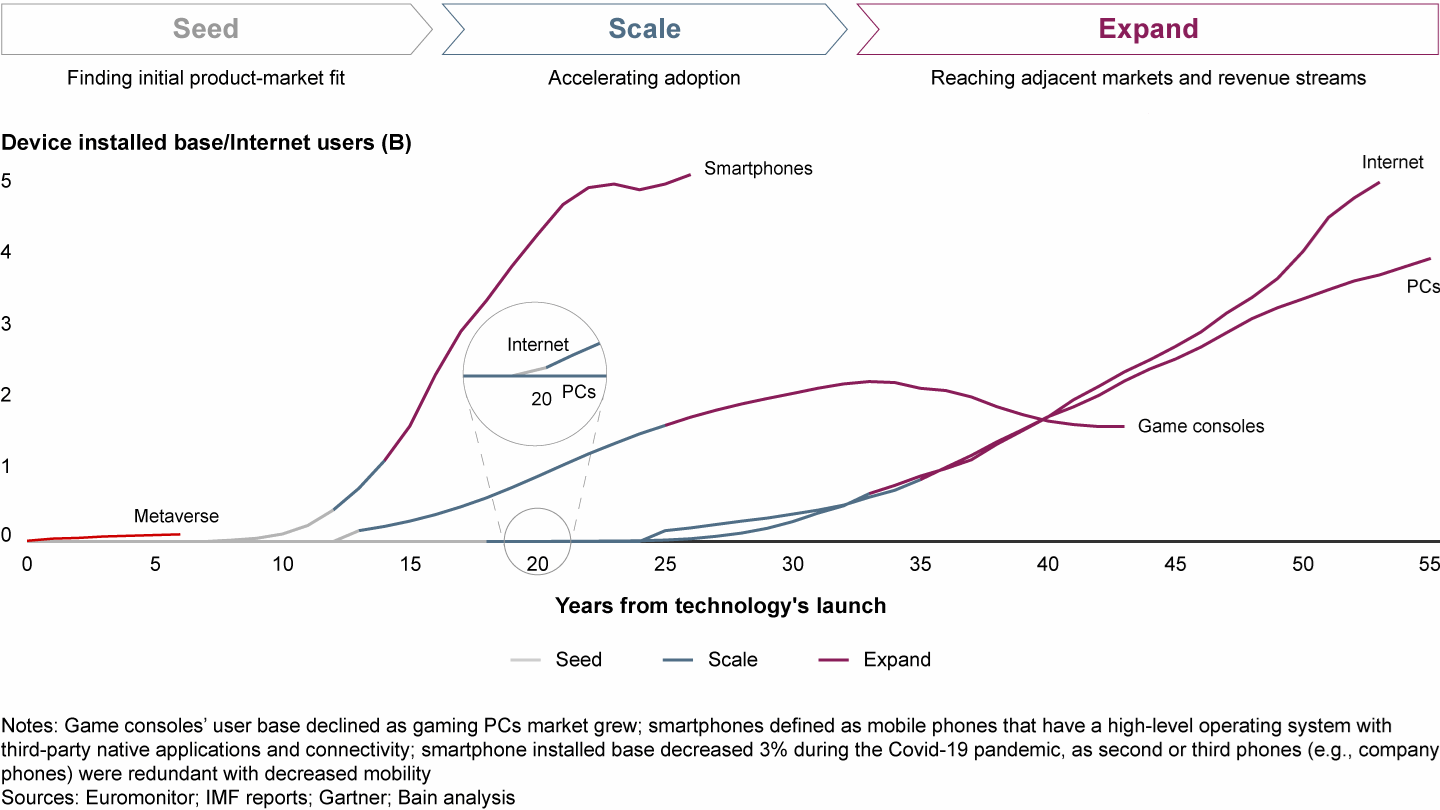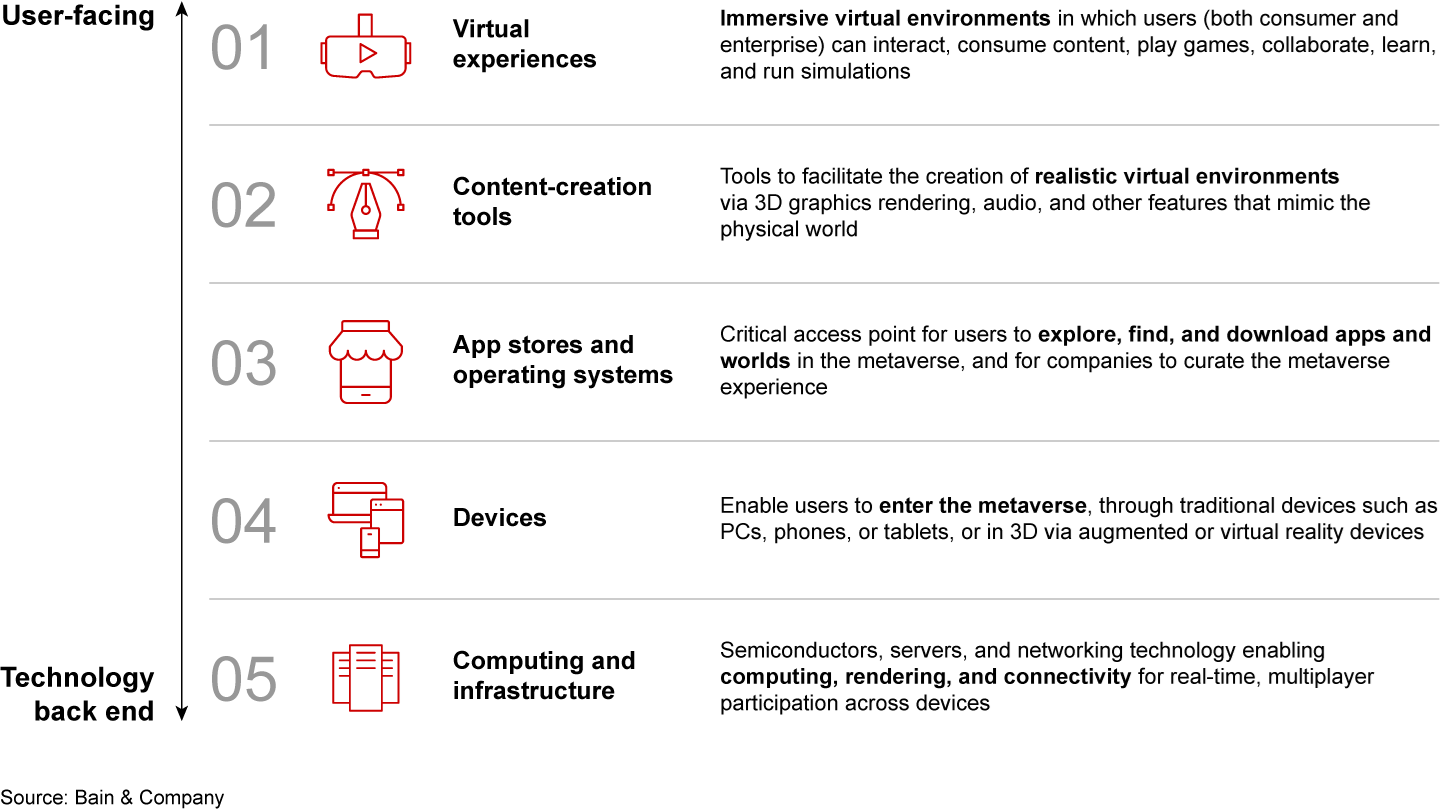Technology Report

Executive Summary
- The metaverse is here, with immersive gaming platforms boasting hundreds of millions of monthly active users, and emerging metaverse technologies deployed across industries.
- Bain projects that the metaverse could reach a market size of $700 billion to $900 billion by 2030 and that the major winners will likely be determined in that time frame.
- While it’s unclear how the competitive landscape will shift, five tech battlegrounds will shape the metaverse: virtual experiences, content-creation tools, app stores and operating systems, devices, and computing and infrastructure.
This article is part of Bain's 2023 Technology Report.
The debate over what the metaverse will ultimately become misses the more salient point: The metaverse is already here.
People imagine a future straight from the sci-fi novel-turned-movie Ready Player One, in which we would spend most of our time living in completely immersive virtual worlds. But when we break it down, the metaverse is a collection of immersive, collaborative, and interactive environments that span digital and physical worlds and enable us to create, exchange, socialize, and learn. And that part of the vision already exists.
Popular gaming platforms today—Fortnite, Roblox, and Minecraft—are becoming more interactive, enable users to create avatars and worlds within them, and deepen the level of immersion players experience by delivering increasingly photorealistic content. They’re also doing this on a massive scale. Each of the platforms mentioned has around 200 million monthly active users, on par with the respective number of subscribers of Amazon Prime and Disney+.
In the business world, a suite of emerging metaverse technologies that leverage virtual reality (VR) and augmented reality (AR) are already providing value. These include applications in areas of high risk (e.g., AR-assisted spinal surgery) and high expense (e.g., jet engine manufacturing) in which interacting with digital models can help improve care or save money.
While it’s challenging to predict exactly how the metaverse will look decades from now, it’s clear that the journey is well underway and there’s a real and growing economic opportunity. We project the metaverse could reach a market size of $700 billion to $900 billion by 2030. Furthermore, the next 5 to 10 years will likely determine the metaverse’s major winners (more on this below).
A multiyear tech boom and free-flowing venture capital fueled a lot of excitement about the metaverse over the past few years. Now, as executives map their strategies in a very different economic environment, we think framing the discussion through the following lenses will help determine where to focus their metaverse investments.
The metaverse will take years to reach full scale
The metaverse will likely remain in the first phase of development—what we call the “seed” stage of the platform development journey—for at least another 5 to 10 years (see Figure 1). Reaching scale requires bringing compelling, breakthrough use cases to market in a format that enhances user experiences. It took more than 10 years for smartphones and gaming consoles to each exit the seed stage and begin scaling up, while it took almost 20 years for the Internet and personal computers, respectively.
The metaverse may take 5 to 10 years to begin scaling, based on the evolution of analogous technologies


Nevertheless, it wouldn’t be surprising if the metaverse grew faster than other influential technologies, given how the pace of change has accelerated. And if a company waits for the metaverse to reach the scale phase before it enters the market, it’s likely already too late. Big market winners often emerge during the seed stage: think Microsoft and Apple in PCs, Nintendo in video games, or Apple’s iPhone in smartphones and iPad in tablets.
Today, a mix of metaverse strategies exist, from companies with a vertically integrated approach that spans multiple segments of the metaverse technology stack to those with a horizontal strategy that focuses on a single layer of the stack. It remains to be seen which will prove to be most effective as the market develops, and the shape of the ecosystem (vertical vs. horizontal) is likely to evolve over time. Meta has established an early lead among those focused on vertical integration, combining leading hardware, app stores, and virtual content in pursuit of widespread user adoption and engagement. The company’s vertical approach allows for tight coupling of hardware and content and, therefore, strong curation of the user experience.
Another notable company with a vertical strategy is Apple. It entered the market in June with the announcement of a mixed-reality headset that combines AR and VR, uses Apple-designed chips and an Apple-designed operating system, and connects with Apple’s existing app ecosystem.
Companies that have adopted a more horizontal approach include Nvidia and Epic Games. Rather than build end-to-end technology stacks, they supply silicon and content-creation tools, respectively, that are used by many companies in the metaverse ecosystem.
The metaverse will be plural
Today’s consumer and enterprise applications will become increasingly immersive and collaborative, moving closer to the most aspirational vision of the metaverse by unlocking richer experiences and better functionality (see Figure 2). And while it’s unclear how the competitive landscape will shift and potentially converge, it’s unlikely to become one big platform dubbed “the metaverse.”
Today’s consumer and enterprise apps already exhibit metaverse attributes and are evolving quickly
Although open standards initiatives have attracted the attention of major tech companies, including Microsoft and Meta, an industrywide shift to a truly interoperable metaverse likely won’t happen anytime soon. Similar to today’s Internet, private companies have strong incentives to maintain “walled gardens” and the companies’ proprietary datasets within them so that they can effectively monetize and recoup the investments required to develop metaverse technologies.
Rather, platforms with large user bases today may take steps to become increasingly immersive and engaging, while smaller, metaverse-like worlds will try to attract bigger user bases. The size of these walled gardens will depend on their ability to tap into network effects and spur user-generated content, kicking off a flywheel effect that accelerates the platform’s growth. These efforts won’t preclude open standards initiatives from making progress, but walled gardens will likely remain more prevalent for the foreseeable future.
Five battlegrounds are shaping the metaverse
Metaverse profit pools are likely to accrue across the technology stack at key control points (see Figure 3). In short strokes, here’s where the most consequential competitive dynamics are taking place.
In the tech industry, there are five key metaverse battlegrounds


- Virtual experiences (about 65% of metaverse projected market size in 2030): Although gaming is currently the leading consumer metaverse application, immersive fitness and entertainment could also be compelling in the medium term. On the enterprise side, innovative use cases are emerging, primarily in collaboration and productivity but also in digital marketing, employee training, education, and healthcare.
- Content-creation tools (about 5% of metaverse market size in 2030): There’s a growing field of software tools that provide the building blocks, editing platforms, and interfaces for creating metaverse worlds and experiences. Many leading platforms offer simple drag-and-drop world-building features that are typically free and intended to cultivate user engagement, retention, and monetization. Generative AI will also transform the way content is created by making it easier to create avatars, in-world assets, and interactions with virtual characters. Meanwhile, developer tools continue to advance, both for consumers and enterprises.
- App stores and operating systems (about 10% of metaverse market size in 2030): We expect the metaverse to follow the smartphone model, with app stores serving as the primary access points for users to explore apps and worlds in the metaverse. The app store role will be even more crucial during the metaverse’s seed stage, helping provide users with curated, high-quality experiences to keep them engaged with the platform and headset they use to access the metaverse; this need is amplified by the immersive nature of VR content.
- Devices (about 10% of metaverse market size in 2030): Significant technological barriers must be overcome before the arrival of comfortable, lightweight, standalone devices that allow for truly immersive experiences. To achieve mass adoption, metaverse content will need to work across all types of devices—including, for the foreseeable future, personal computers, gaming consoles, and smartphones. These device manufacturers may see their businesses benefit as some consumers opt for their higher-end product lines to unlock more immersive, collaborative experiences.
- Computing and infrastructure (about 10% of metaverse market size in 2030): Demands on computing power will continue to grow significantly. That will pressure hardware companies to develop higher-performing chips, servers, and networking technologies to render high-quality graphics and reduce latency. Improvements are already underway, including 5G network rollouts and advances in system-on-chip performance.
While executives can’t ignore the metaverse, neither are we suggesting that every company pivot its entire strategy to focus on this sector. It’s more about making targeted adjustments to existing roadmaps to ensure that the company moves in the same direction as its ecosystem of customers, partners, and competitors. No one knows exactly what the metaverse’s final destination will be, but all signs indicate it’s going to be a journey well worth taking.